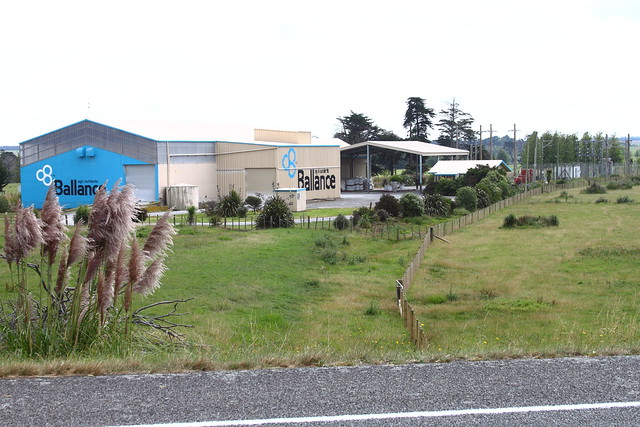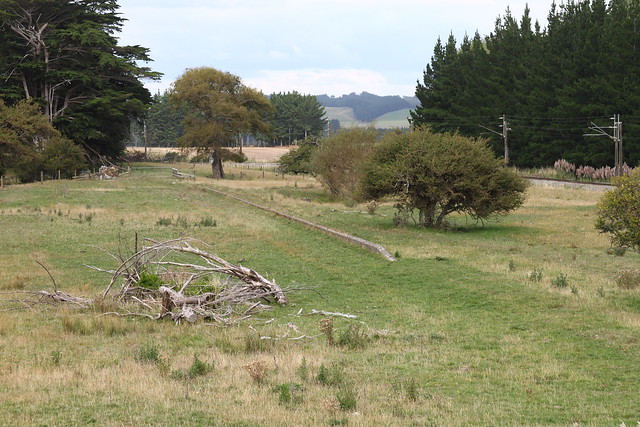http://rsnz.natlib.govt.nz/volume/rsnz_70/rsnz_70_03_003990.html
Based on the above information we have the date of the abandonment of the tunnel placed as 1934/5. Specifically
Puketeraki Railway Tunnel.
Some idea of the rate of these slumping movements may be obtained from the records of displacement at the Puketeraki railway tunnel, which through the courtesy of the Otago District Engineer for Railways, the writer was permitted to study (See Fig. 3). The tunnel was cut through a northward-facing bluff of Caversham Sandstone, and enters into what is actually the face of a slump-scarp a short distance above the underlying mudstone. The tunnel is 516 ft. long and rises southwards with a slope of 1 in 66, crossing several major as well as minor surfaces of slump-movement. The displacement along these was soon made obvious by the disruption of the tunnel-lining, and necessitated repeated repair, regarding and realignment. Comparison made in 1932 between the elevations of points taken at 10 ft. intervals along the axis of the tunnel (crown of the tunnel-arch) and those determined at the time of its construction in 1878 (the northern portal being used as the datum-point), showed that there were three main slump-faults between which strips, respectively 50, 150 and 100 ft. wide, subsided with a backward rotation at an average rate of 0° 1′ 7”, 0° 0′ 24”, and 0° 0′ 5·8” respectively per year during the 54-year interval. The greatest differential movement (12 inches) occurred between the middle and inner strip, and this slump-fault is continued upward from the tunnel into the small slump-scarp about 18 inches high on the top of the bluff over the middle of the tunnel. This scarp was thus scarcely in evidence when the construction of the tunnel was commenced.
In order to obtain more nearly the absolute measurements of the displacement of the tunnel-axis a line of sight from a datum-point fixed in the station yard in 1928, and controlled by azimuth-readings to distant trigonometrical stations, was taken as the base-line for measurements of the position of seven points at various intervals along the crown of the tunnel-arch, and repeated measurements were made at intervals between 1928 and 1936. Taking those made before June, 1934, it may be deduced that the annual rate of backward rotation of the middle and inner slumping strips had then increased to 0° 0′ 42″ and 0° 8·2′ respectively, and that the average rate of subsidence at six of the points observed by reference to the seventh point near the north portal (most nearly stable* during the 54-year interval) had increased by 80%, these increases probably resulting from the increased vibration caused by heavier and more frequent trains. The determination of the eastward as well as the downward component of the displacement showed that each slumping strip had a double movement of rotation, the backward rotation about an axis parallel to the face of the scarp, and a seaward slipping also with backward rotation about a line nearly perpendicular thereto; for the resultant direction of lateral slipping is inclined more steeply than the bedding plane of the Burnside Mudstone on which the movement takes place. The average rate of monthly slipping (varying between 0·08 and 0·29 inches) during the several intervals between the successive measurements accords closely with the value of 0·0138 R2.70 inches, where R is the mean of the average monthly rainfall during these intervals at the two official recording stations nearest to Puketeraki (respectively 12 and 16 miles to the N.N.E. and S.S.W.). If R should approximate to the average monthly rainfall at Puketeraki, the above relation may indicate at least qualitatively the dependence of the rate of slipping on the amount of water percolating down the fissures in the Caversham Sandstone to lubricate the sloping surface of the Burnside Mudstone on which it rests.
Between July, 1934, and September, 1936, when the measurements were discontinued, the deviation-cutting and embankment were being built, and the use of the tunnel was abandoned. The displacements of the observed points greatly diminished, and after April, 1935, appeared to cease, in part, no doubt, because of the excellent drainage of the fissures afforded by the new cutting, but possibly also because the extra load imposed by the weight of the 87,000 cubic yards of sandstone, which makes the new embankment on the mudstone in the vicinity of the datum point for observations, may have so increased its tendency to creep seaward as to have reduced below the limits of observational error the movement of the tunnel in reference to that of this datum point.

The location of this photo is not confirmed, but is possibly the Puketeraki Tunnel, taken in 1910/11. If this is correct, the photo would have been taken at the northern portal near the Puketeraki railway station.

Puketeraki Railway Station around 1910/11. As both of these photos were possibly taken by the same photographer on the same day it helps to support the suggestion that the previous photo is the Puketeraki Tunnel.
Both photos are from the Hocken Snapshop being taken by J A Birrell of Dunedin.


































